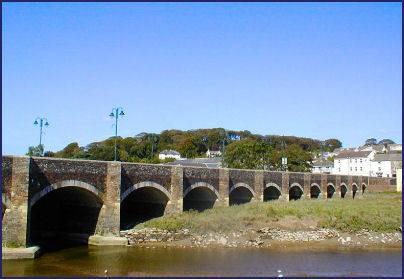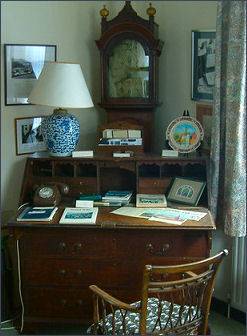Wadebridge
OS Grid ref:- SW990725
 The busy market town of Wadebridge, known in Cornish as Ponsrys, is situated on the beautiful Camel Estuary around five miles (8 km) upstream from Padstow.
The busy market town of Wadebridge, known in Cornish as Ponsrys, is situated on the beautiful Camel Estuary around five miles (8 km) upstream from Padstow.
The town has it earliest recorded reference in 1313 when a market and two fairs were granted to Wade, within the manor of Pawton. The original settlement of Wade was founded on the site of a ford on the River Camel. The first bridge over the Camel, "the Bridge on Wool" replacing the ford was constructed in 1468 under the auspices of the local vicar, Reverend Thomas Lovibond and was financed by profits from the wool trade. The bridge has seventeen arches and is 320 feet long. It was widened in 1847 and is recognised as being one of the finest examples of a medieval bridge in England.
Further upstream stands a modern footbridge across the river that links the residential area of Egloshayle with the town centre. The Challenge Bridge was constructed in record time in 1991 by the BBC television programme "Challenge Anneka".
The town hall was built from 1886 to 1888. A large mural of St. Mabyn painted by Mr. V. Harvey which depicts the bridge under construction, can be seen at the back of the building. The church at Egloshayle is situated near to the River Camel, the name means church by the estuary in Cornish. The church is dedicated to the sixth century St Petroc, who landed in Cornwall from Ireland, founding monasteries at Padstow and Bodmin. The church tower soars to eighty feet high and was gifted by the Reverend John Lovibond. The church is largely medieval in construction, with later connections with the Molesworth-St Aubyn family of Pencarrow House.
 On the site of the old railway station stands the Betjeman Centre. Betjeman's love of North Cornwall influenced many of his more well-known works. There is a memorabilia room dedicated to the poet laureate. On display are various personal effects, academic honours and furniture which belonged to Sir John Betjeman.
On the site of the old railway station stands the Betjeman Centre. Betjeman's love of North Cornwall influenced many of his more well-known works. There is a memorabilia room dedicated to the poet laureate. On display are various personal effects, academic honours and furniture which belonged to Sir John Betjeman.
The main shopping centre, Molesworth Street, is pedestrianised and there is a new shopping precinct by the River Camel in Eddystone Road, where the Tourist Information Centre is also located.
Nearby Pencarrow House is an imposing Georgian house dating to 1765, which is still in the ownership of the Molesworth-St. Aubyn family. Pencarrow contains much fine furniture including the piano used by Sir Arthur Sullivan in composing Gilbert and Sullivan's Iolanthe in 1882. The house is surrounded by five hundred acres of parkland, woods and formal Grade II Listed gardens.
The Camel Trail, one the of Cornwall's most popular off road cycling facilities, follows the route of a disused railway track and is is part owned by North Cornwall District Council and by Cornwall County Council. Managed as a Partnership involving local community organisations, the 17 mile long Camel Trail is carefully maintained and promoted in order to accommodate the 350,000 users each year. The trail links towns of Bodmin, Wadebridge and Padstow. An extension to the route follows the river towards Camelford.
The John Betjeman Centre
 When the railway line which followed the route of what is now the Camel Trail was still functioning, the poet laureate Sir John Betjeman (28 August 1906 – 19 May 1984) famously made the train journey, describing it as 'the most beautiful train journey I know" and, at the end of the line, a different world awaited him, one of “oil-lit farms” and “golden unpeopled bays”, of shipwrecks and haunted woods, which he explored while staying at one of his father’s properties in the village of Trebetherick midway between Rock and Polzeath.
When the railway line which followed the route of what is now the Camel Trail was still functioning, the poet laureate Sir John Betjeman (28 August 1906 – 19 May 1984) famously made the train journey, describing it as 'the most beautiful train journey I know" and, at the end of the line, a different world awaited him, one of “oil-lit farms” and “golden unpeopled bays”, of shipwrecks and haunted woods, which he explored while staying at one of his father’s properties in the village of Trebetherick midway between Rock and Polzeath.
The rugged North Cornish coast inspired some of Sir John Betjeman’s most celebrated and evocative poetry. Betjeman succeeded C.Day-Lewis as Poet Laureate in 1972. He had a lifelong love of Cornwall and in particular North Cornwall. There are many beautiful evocations of the Cornish landscape to be found in his poetry such as: Cornish Cliffs, By the Ninth Green, St Enodoc, Tregardock and Old Friends.
He was also active in Cornish affairs, insisting that Cornwall was not part of England, and championing Cornish environmental concerns that anticipated today's focus on sustainability. John Betjeman died on May 19th 1984, at his home in Trebetherick. He was buried in the nearby church of St.Enodoc.
The John Betjeman Centre in Wadebridge, housed in the old Wadebridge railway station which is mentioned in Betjeman's poem 'Summoned by Bells', displays various memorabilia and personal items belonging to the famous poet including his desk and telephone from his home in Trebetherick. It also contains a superb collection of his books, medals and photographs. The centre is open Monday to Friday.